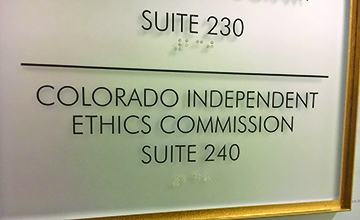
by Charles Bonniwell | Mar 21, 2023 | Main Articles
PART I
by Charles C. Bonniwell

David vs. Goliath: The little town of Glendale is fighting the IEC for the rights of all citizens and home rule cities in Colorado.
The City of Glendale and its officials have been caught in a maze of Star Chamber proceedings before the Colorado Independent Ethics Commission (IEC). They have been fighting for eight long years with no end in sight over a minor mix up in a City Council meeting in May of 2015. They, like almost anyone and everyone who has appeared before the IEC, have tales of woe to tell.
The IEC was created when the Colorado voters approved Amendment 41 to the state constitution titled “Ethics in Government” in 2006, promoted by now Governor Jared Polis, who was then co-chair of “Colorado for Clean Government.” Polis was made a multi-millionaire due to his mother’s floral business and objected to usually poorly paid politicians and bureaucrats getting gifts or any benefit worth more than $50.
Limitless Power

All Powerful: The IEC, a little-known bureaucratic entity, has become so powerful, that even the biggest political heavyweights are no match for it.
But the key to the Glendale quagmire and the horror shows of many who find themselves before the IEC was a little noticed catch-all provision of Article XXIX, Section 5, which says that the IEC can “hear complaints, issue findings, and assess penalties … on ethics issues … under any other standards of conduct and reporting requirements as provided by law.” Under an expanded interpretation of that provision the IEC may one day control the entire state, including doctors, lawyers, architects, judges, and anyone else if it wishes.
The key to the IEC assuming more and more power over the state and its citizens was to do it slowly while hopefully not alarming the courts or the media until it became too powerful to stop. The IEC stayed under the radar until a lawyer, Bill Leone, who headed up a New York firm’s white collar crime unit in New York City, was appointed by Governor John Hickenlooper. The appointment was to his everlasting regret. The IEC is composed of five members, one appointed by the Governor, one by the State House of Representatives, one by the Chief Justice of the Colorado Supreme Court, and one by the other four commissioners. No more than two members can belong to the same political party.
Leone

Power Is Where Power Goes: New York lawyer Bill Leone ruled over the IEC for eight years with an iron fist and crushed all who appeared before the organization.
Considered by his critics to be a narcissist megalomaniac, Leone began expanding the IEC powers in every direction after his appointment. A former interim U.S. Attorney, he was considered for firing by the U.S. Justice Department. He was passed over for a permanent position. Nominally a Republican, Hickenlooper believed he was, in reality, a Democrat he could safely appoint.
The IEC would eventually become known by political insiders as a place where ethics was ignored but where you could destroy your political opponents no matter how powerful. One of those shadowy lawyer insiders was a Democrat interim Secretary of State Bernie Buescher, appointed by Democrat Governor Bill Ritter when Republican Mike Coffman resigned as Secretary of State in 2009. During his two years as Colorado Secretary of State he learned he could bring devasting charges on minor matters to destroy political opponents. He brought that knowledge to the Denver law firm of Ireland Stapleton in an “of counsel” position in their Grand Junction office.
The Meatgrinder
The IEC’s power comes from the fact that the IEC acts as judge, jury, and executioner, with no checks or balances. All one has to do is file a complaint, no matter how trivial, claiming any minor conflict of interest or gift over $64. The IEC, behind closed doors in secret meetings, determines if it has “jurisdiction” which depends on arbitrary, obtuse standards of which there is little rhyme or reason, but appears to be whether the members politically like or dislike the target citizen.
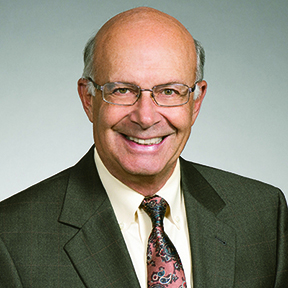
Insider: Bernie Buescher, a shadowy lawyer, is believed by those in the know to be an expert in the dark arts involving the IEC.
If they would like to go after the target citizen, they appoint an investigator which is normally its executive director Dino Ioannides, or it is farmed out to private investigators. The accused have no rights or protection. The IEC decides whether it wants to go ahead or not and if so an attorney from the Colorado Attorney General’s office acts as prosecuting attorney with the IEC as the judge and jury. The complainant who has started the process has no role or obligations and is not required to spend money. The target citizen faces tens of thousands or even hundreds of thousands of dollars in fees if he or she wishes to fight the complaint.
If the IEC finds for its own attorney and finds the target guilty, then it imposes its penalty, which for gifts, is twice the amount of the gift, but in other cases who knows. While the target citizen is often facing a couple of hundred dollars fine they must also pay massive attorney fees, which is why most target citizens simply fold and admit guilt regardless of the veracity of the complaint. If by some miracle you are found not guilty of the complaint, you are not entitled to a reimbursement.
The complainant incurs no costs in the proceedings and has the thrill of its political opponent pleading guilty to an ethics complaint. If the target citizen does fight the charges, they will incur the huge legal fees and will likely be found guilty by the IEC kangaroo court. If the IEC doesn’t take the case you still have the advantage of politically embarrassing your political opponent/ citizen target by filing an ethics complaint.
Scott Gessler

Victim: As Colorado Secretary of State, Scott Gessler became the first victim of the IEC’s expanded powers.
The first political whale that was captured by Leone and the IEC was Republican Colorado Secretary of State Scott Gessler. He had flown to Tampa in 2012 to attend and speak at the “National Election Law Seminar,” a two-day continuing legal education conference. Under Colorado law, each of five statewide elected officials, including the Secretary of State, has access to a modest annual discretionary fund to spend “in pursuance of official business.” Left-leaning Colorado Ethics Watch filed a complaint asserting it did not consider Gessler’s trip in furtherance of official business and charged that Gessler had failed to turn in receipts for another $117 taken from the discretionary fund.
The Colorado Supreme Court in 2018 in Smith v. Gessler shot down the argument that the IEC’s jurisdiction was limited to “matters of gifts, influence pleading, and standards of conduct, and reporting requirements that expressly delegate enforcement to the IEC.” Instead, the court bought hook, line, and sinker that jurisdiction of the IEC covers any complaints “under any other standards of conduct … as provided by law.”
Gessler’s legal fees fighting the IEC, which were covered by the state, eventually reached approximately a half a million dollars. The total fine was only a little over one thousand dollars. The IEC as a political monster was born. Political insiders, both Republican and Democrat, knew that filing a complaint with the IEC would likely bankrupt a target citizen if they sought to fight it.
John Hickenlooper

Victim 2: Former Governor John Hickenlooper was so broken by the IEC, that he stopped fighting in order to end the proceedings.
After Leone’s four-year term was up on the IEC in 2017, Governor Hickenlooper apparently refused to reappoint the power-hungry Leone. So Leone went to the Republican president of the Senate, Kevin Grantham, to reappointment him for another four year term. Hickenlooper was about to learn about political payback from the now all-powerful IEC and Commissioner Leone.
Hickenlooper had traveled at various times on planes of friends while he was governor. Hickenlooper was running for U.S Senate against incumbent Republican Cory Gardner. Republican operatives like fomer Republican Speaker of the House Frank McNulty had seen what Democrats had done to Scott Gessler and decided two could play the game. They had Republican interest groups file a complaint for those trips and other items and Commissioner Leone was waiting with bated breath.
Even the former Governor did not have any chance against the IEC, even with the state covering his legal fees involved in fighting the IEC. When he refused to comply with the IEC subpoena, the IEC went to court and the judge ruled his refusal was in contempt. Hickenlooper refused to testify and basically laid over so as not to delay the inevitable, as he was suffering politically. He incurred a fine of $2,750 but at least was free from the political monster that the IEC had become.
Part II Next Edition
In Part II next month, learn how the IEC regularly rolls over average citizens without a thought. Learn how the Village of Glendale was trapped in the IEC meatgrinder, and how it has tried to fight off the all-powerful IEC.
by Valley Gadfly | Mar 21, 2023 | Main Articles
Hippity Hoppin’ Down The Bunny Trail To Easter, Rebirth, New Life, And Spring’s Egg’stra Special Season
by Glen Richardson

Easter Brunch Bunch: Families celebrate the holiday at indoor-outdoor restaurant gatherings, including brunch in the regal 19th-century dining room at the Brown Palace Hotel downtown.

Colorful Easter Character: The Bible makes no mention of this long-eared, short-tailed character, nevertheless, the Easter bunny is a prominent symbol of Christianity’s Easter holiday.
Easter — April 9 this year — has become a charming Cherry Creek Valley tradition bringin’ baskets full of fun spring things to do ranging from egg hunt extravaganzas and bunny bolts to scrumptious spring feasting. Along with Easter Sunrise Service at Red Rocks and city-wide church services, the holiday is anchored by Passover which starts at sundown April 5 and ends April 13.
The holidays coincide with “Bud-Bust” — tell-tale signs that spring is upon us — as the Valley revives and reinvigorates after the colder months. Bees start buzzing as grass begins to grow again and flowers bloom.
From church services and colorful events to Easter eating, the Chronicle has found copious choices beyond dying eggs to keep you hoppin’ into spring:
Easter Services
Red Rocks Sunrise Service
Service is at Red Rocks Amphitheatre in Mor

Hatching Hunts: A tradition since 16th-century Germany, children search for decorated eggs a various Valley sites including Glendale’s Infinity Park Turf Field and Four Mile Historic Park.
rison, April 9. Gates open 4:30 a.m., pre-worship music at 5:30 a.m., service begins at 6 a.m. Speaker is Father Michael Nicosia, Priest at the Ecumenical Catholic Communion, Aurora. Music is by Blood Brothers, a folk, country, and worship music quintet. Information: 303-825-4910.
Augustana Lutheran Church
Located at 5000 E. Alameda Ave., Augustana’s Easter Garden will be in full bloom with music by the Easter Brass and Augustana’s Chancel Choir, 8 a.m.

April Showers Spark Flowers: Rain showers spark the beginning of flowers and plants to really start blooming. Symbolizing a fresh start, daisies and sweet peas are the flowers of April.
Information: 303-388-4678.
Catholic Basilica Of The Immaculate Conception
Holy Week at the Basilica on the corner of Logan St. and Colfax Ave. has the church’s most beautiful liturgies. Holy Saturday Vigil is 8:15 p.m., Easter Sunday Mass is at 8:30 a.m., 12:30 p.m., and 6:30 p.m. Information: 303-831-7010.
Saint John’s Cathedral
Cathedral is seat of the Bishop of the Episcopal Diocese of Colorado at 1350 N. Washington St. Service is at 10:30 a.m. with music by St. John’s School & Adult Choir. An Easter egg hunt follows from noon to 12:30 pm. Information: 303-831-1350.
University Park United Methodist Church
Church located at 2180 S. University Blvd. has 7 a.m. sunrise service on the Colgate Lawn followed by traditional worship in the sanctuary 9 a.m.-11 a.m. Information: 303-722-5736.
Assumption Of The Theotokos Cathedral
Greek Orthodox Easter — celebrated Sunday after Passover’s first full moon — is April 16 at the Cathedral in Glendale. Divine Liturgy, 9:30-11 a.m., ritual Greek Easter Dance (Cretan), 12:30 p.m.; Pan Orthodox Vespers, 5 p.m. Information: 303-388-9314.
Passover
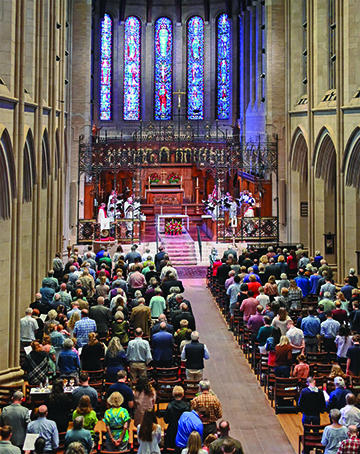
Spring Services: In addition to Easter Sunrise Services at Red Rocks, St. John’s Cathedral (pictured) and churches city-wide celebrate with special services, music, and the ringing of church bells.
Judaism Your Way
Community Seder at Denver Botanic Gardens April 8, 5-8 p.m. Rabbi Caryn Aviv and Amanda Schwartz led Seder will feature High Holiday songs and Seder classics. Information: 303-320-6185.
Temple Emanuel
Passover day one service is April 6 followed by Young Family Pesach April 12. Temple’s Passover Seder is a buffet style dinner catered by Cohen’s Cuisine in the Social Hall April 5, 6 p.m. Seder will be led by Rabbi Joseph Black, Cantor Elizabeth Sacks, and Rabbi Emily Hyatt. Information: 303-388-4013.
Easter Egg Hunts
Glendale Sports Center
Egg Hunt is April 1 at Glendale’s Infinity Park Turf Field, 10 a.m. Hunts are for kids in three age groups: ages zero-three; four to six; and seven to age 12. Parking is available on the northeast corner of Kentucky & Cherry. Information: 303-639-4711.
Four Mile Historic Park
Hunts April 8 are at 9 a.m. and again at 1:30 p.m., beginning with Puppet Shows at 9:15 a.m. and 1:45 p.m. Morning Little Kid Egg Hunt is at 10 a.m. followed by Big Kid Hunt at 10:30 a.m., shadowed by a Magician at 11 a.m. Doors close at noon. Afternoon hunt doors open at 1 p.m., Little Kid hunt is at 2:15 p.m., Big Kid Hunt 2:45 p.m., with Magician at 3:15 p.m. Afternoon hunt closes at 4:30 p.m. Victorian Egg Rolling Contest, Musical Egg Chairs & Crafts all day. Information: 720-865-0800.
Stapleton Egg Scramble
The Stapleton Master Community Assn. annual scramble is April 1, 10 a.m. The first scramble is for children six and older (Parents not allowed); followed at 10:15 a.m. by ages zero to five, parents allowed. Information: 303-388-0724.
Easter Brunch
Bistro Vendome
Relocated from Larimer Square to 2267 Kearney St. in Park Hill, restaurant is expected to again feature Easter brunch. Anticipate omelets, Crepe Vendome, other popular selections, and their Chocolate Croissants. Information: 303-825-3232.
Edge Restaurant
Hop over to the Edge Restaurant & Bar in the Four Seasons Hotel downtown April 9, 9 a.m.-2 p.m. Featuring a raw bar, appetizers, salads, several entrée options, plus a carving station. Information: 303-389-3050.
Ellyngton’s
Appreciate breakfast and Easter brunch in the restaurant’s regal 19th-century dining room at the Brown Palace Hotel. Choices include waffles, pastries, omelets, salads, sushi, grilled meats, many more choices. Information: 303-297-3111.
Fire Restaurant
Experience brunch in one of the most desirable indoor-outdoor Easter settings at the ART Hotel on Broadway, 10 a.m.-2 p.m. Spring omelets, much more, plus a Bunny Menu for the kids. Information: 720-709-4431.
Local Jones
For a tasty holiday morning in Cherry Creek North, do brunch at this classic bistro in the Halcyon Hotel. Always delightful, choices usually include cinnamon rolls, roasted lamb shank, and more. Information: 720-772-5022.
Washington Park Grille
Enjoy a laidback ambiance at this Old S. Gaylord St. eatery with low-key dining room, lounge, and patio. Warm atmosphere with yummy choices such as waffles, omelets, a crab benedict, and more. Information: 303-777-0707.
Easter Dinner
Culinary Dropout
Eatery on E. 9th Ave. is offering two additional items on Easter weekend plus the regular menu. Standard items include Rainbow Trout, Squash Ravioli, and Fried Chicken. Information: 720-799-0190.
Humboldt Kitchen
Serving a special Easter Dinner featuring Herb Roasted Prime Rib from 3 p.m.-8 p.m. A holiday brunch is offered from 10 a.m.-2 p.m. The regular menu also available. Information: 303-813-1700.
Le Bilboquet
Restaurant on corner of 3rd Ave. & St. Paul in Cherry Creek offers dinner on Easter, plus a buffet. Last year’s choices were grilled chicken, Spaghetti & Meatballs, and Mac & Cheese. Information: 303-835-9999.
Monaco Inn Restaurant
Serving noon to 8 p.m., restaurant is featuring Colorado Spring Leg of Lamb with Greek potatoes, Greek Salad, and Avgolemono Soup. Menu also has other Greek & American specialties. Saganaki appetizer, plus homemade baklava or galaktoboureko for desserts. Information: 303-320-1104.
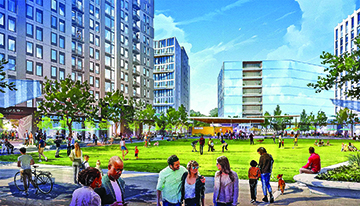
by Valley Gadfly | Feb 22, 2023 | Main Articles
With Lowest Vacancy Rates And Highest Office, Retail, And Multi-Housing Rents, Megaprojects Are Hijacking District’s Westside
by Glen Richardson
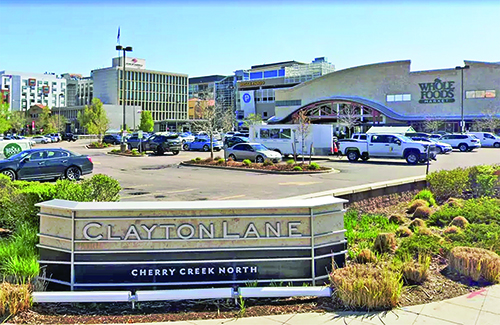
Whole Lot Of Wavering: Known as Clayton Lane, the site where Whole Foods and the former Sears store are located, continues to be Cherry Creek North’s most tentative development.

Billion Dollar Deal: East West Partner’s $1 Billion Cherry Creek West project is Cherry Creek North’s biggest project and will have the most impact on the district’s changing westside.
Developers are making bold moves to turn Cherry Creek North’s westside — where what remains of the district’s independent stores, spas, salons, and eateries — into sprawling mega developments. The push to “go big” represents both a growing demand and developer desire to land larger retail and housing tenants in mega mixed-use campuses.
Cherry Creek North has the lowest vacancy rates and highest office, retail, and multi-housing rents in metro Denver, making the district the Valley’s hottest market for investors and lenders alike. Moreover, Cherry Creek has become the leading leasing market in the Rocky Mountain region, attracting the highest demand for properties and spaces available for Lease and Sublease.
Consequently, the district is now one of the nation’s best performing submarkets. Here’s the latest on new megaprojects, plus an update on impending projects:
Coup At 210 University
A $67.7 million, 140,832-sq.-ft. office-retail joint development by Koch Real Estate Investment (KREI) and Corum Real Estate Group at 210 University Blvd. is Cherry Creek’s latest westside development takeover wave. The nine-story office building and attached garage — where US Bank and Baird are located — will remain intact.
But the companies plan to demolish the existing single-story retail buildings on 3rd Ave. — where Chinese restaurant Little Ollie’s has been located since 1997 along with the adjacent OBar — plus the next-door Paradise Cleaners. The development duo plans to build a four-story structure with 7,500-sq.ft. of ground floor retail space and three floors and 46,000-sq.-ft. of office space on the site. Construction won’t begin for at least a year, since leases for the restaurant-bar and cleaners require a year’s notice before termination.
The Sunflower Bank building — located next to the cleaners on the corner of Josephine and 3rd Ave. — was not involved in the purchase and won’t be demolished.
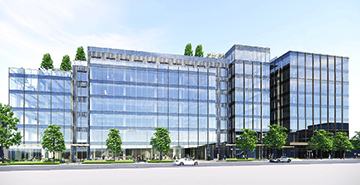
Clayton’s Second Phase: Broe Real Estate has commenced work on the second phase of street’s $200 million redevelopment. Work has started on this eight-story, 175,000-sq.-ft. building.
Josephine St. Changes
Directly across 3rd Ave., Elevation and Edgemark Development have already started construction on a six-story, 70,000-sq.-ft. mixed use building. The location’s first-floor will feature retail space wrapped around the corner of 3rd & Josephine. The upper-floors’ step-up design has 50,000-sq.-ft. of tenant space that will vary from 16,000-sq.-ft. on the second floor to 5,000-sq.-ft on the top-level. The project is on the half-acre site where floral-home furnishing store Bloom was located and includes a portion of parking lot space leased to Hillstone Restaurant.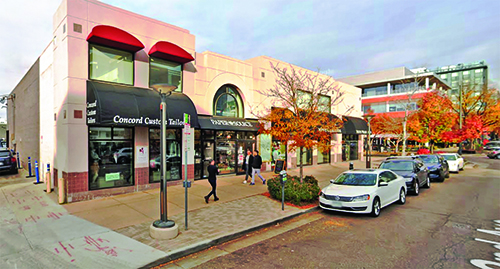
The site at 2nd Ave. and Josephine — where Whole Foods and the former Sears store are located — remains the westside’s most tentative site. Known as the Clayton Lane project, the collection of buildings between East 2nd Ave. from Josephine to Detroit streets was purchased by OliverMcMillan (later acquired by Brookfield Residential) and Invesco Real Estate for $116.7 million in 2016. Initial plans called for demolition of Whole Foods, the adjacent parking structure, and the former Sears store. They were to be replaced by 173,105-sq.-ft. of retail space and 527 residential units between Clayton and Josephine.
News media reports at the beginning of 2023 hinted that “after years of false starts, things might finally get moving in the massive Clayton Lane development.” Those reports, nonetheless, acknowledged, “it’s unclear if the owners plan to sell completely or in part, or are simply looking to bring another firm into the partnerships.” Even if major changes take place, demolition and new construction is likely two to five years away.
$1 Billion Mall Project
That puts the $1 billion East West Partners’ mixed-use development dubbed “Cherry Creek West” as the biggest project with the most immediate impac
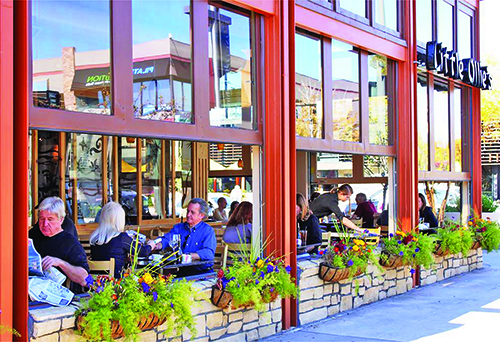
Going, Going, Gone: Newly revealed $67.7 million 210 University Development will demolish Little Ollie’s, OBar, and Paradise Cleaners along the west end of 3rd Ave. in coming year.
t and influence on Cherry Creek North’s changing westside. Construction is scheduled to start in the third quarter of 2024, with the first building ready for occupancy in 2027. Already in the starting stages, the massive site is likely to be completed in 10 years.
The 13-acre site — bordering University Blvd., the Cherry Creek Shopping Center, and Cherry Creek North Dr. — will be composed of seven 12-story tall buildings housing a combination of offices, condos, and apartments. The massive development will span from University Blvd. to Clayton St. and 1st. Ave. to the Cherry Creek waterway.
Plans include a “public plaza” with green space for concerts and events; a market square; a dedicated two-way bike trail; and above- and below-ground parking. Some neighbors are concerned the plans will lead to traffic congestion, with fewer places to drive and a lack of parking. Others say there won’t be sufficient affordable housing.
Clayton’s Second Phase
Sandwiched in the westside’s middle section is Broe Real Estate Group’s $200 million Clayton Street redevelopment. The completed and fully leased phase one projec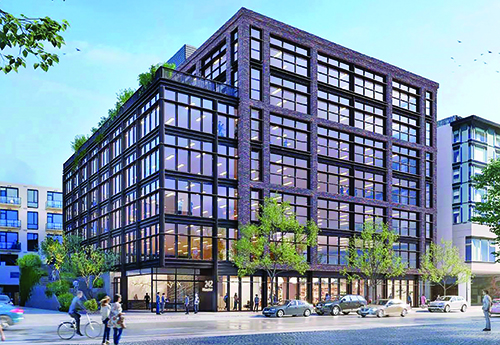 t on the corner of 2nd Ave. and Clayton is 76,000-sq.-ft. and rises eight-stories. The developer — who owns most of the east side of Clayton and has its headquarters on the street — has commenced work on the second phase located at 250 Clayton. It is another eight-story project, this one totaling 175,000-sq.-ft.
t on the corner of 2nd Ave. and Clayton is 76,000-sq.-ft. and rises eight-stories. The developer — who owns most of the east side of Clayton and has its headquarters on the street — has commenced work on the second phase located at 250 Clayton. It is another eight-story project, this one totaling 175,000-sq.-ft.
Along the westside’s eastern-most street, Schnitzer West is launching an eight-story office project at 201 Fillmore St. The development company paid $108 million for the Men’s Wearhouse site, a new Denver record price per square foot. Landlord for the property was Barry Hirschfeld. The 2nd Ave. and Fillmore project will feature 140,000-sq.-ft. of mixed-use space, with 132,000-sq.-ft. being office space. All of the office space has been pre-leased. There will be 8,500-sq.-ft. of retail space on the ground floor. Five levels of below-grade parking will accommodate more than 240 vehicles.
Down the street at 255 Fillmore — a site that has been a parking lot since it was purchased by BMC Investments in 2019 — construction is underway for a seven-story mixed-use project that is expected to be completed as soon as the third quarter of this year. The project will have six floors of office space and 9,500-sq-ft. of ground-floor retail including French-Vietnamese restaurant Le Colonial.

by Regan Bervar | Feb 22, 2023 | Main Articles
“Detestation of the high is the involuntary homage of the low.”
 by Luke Schmaltz
by Luke Schmaltz
David and Goliath are at it again. This time, they are playing out the roles of underdog and oppressor on the unlikeliest of proverbial battlegrounds — the Park Hill Golf Course.
This classic duel has been staged across the Mile High City for decades: A large developer with deep pockets acquires valuable real estate. Then, they set out to build upon the property in dimensions that do not resonate with longtime residents of the surrounding community. Most often, the neighborhood stakeholders lose, but this time the big dog has a hitch in its get-along — a handicap — if you will.
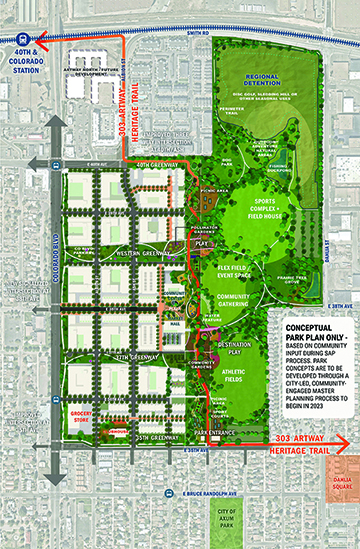
Bird’s Eye View: This is the purported long-term development of the Park Hill Golf Course plan presented by Westside Investment Partners. Critics indicate there will be nothing to stop Westside from turning the rest of the open space into high density units. Image courtesy of Westside Investment Partners and The Holleran Group
Currently the 155-acre Park Hill Golf Course (PHGC) is encumbered by a perpetual conservation easement which, according to the assigned legalese, “Limits use of the property to open space in general and a golf course in particular.”
From the early 1980s until recently, the PHGC was privately owned by the Clayton Foundation. In 2019, Westside Investment Partners purchased the property at a total price tag of $24M. In addition to the conservation easement, the Glendale-based developer faces another obstacle; an organization called Save Open Space (SOS) Denver. Their website states they are, “A grassroots community group focused on the future of the Park Hill Golf Course land.”
Silence The Protestors
SOS Denver spokesperson Harry Doby is deeply immersed in the fight to preserve the massive stretch of grass and trees adjacent to his home. Yet, Doby and his fellow SOS members have faced staunch opposition from the City of Denver. Recently, a comprehensive protest petition signed by adjacent property owners and businesses against rezoning of the land was rejected by city officials, despite the fact that Doby and company followed all rules for filing described on the city’s website. When questioned, the city stood by their rejection of the petition, stating in vague language via email that th
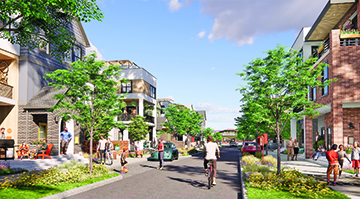
Rendering: Developers present idyllic artist renderings of what the project might look like upon completion. Denverites are skeptical as often the actual finished project is much different than the rendering submitted by Westside. Image courtesy of Westside Investment Partners and The Holleran Group
e documents provided did not meet the legal requirements. “They invented this rule simply to stop our process,” says Doby. “The city has a single-minded obsession with developing this green space. Westside knew going in they had no development rights.”
As a result of ousting the voices of local property owners and businesses, Denver City Council cast a majority vote of 11-2 to place the issue on the April 4th Election Ballot. Now, the decision whether to lift the conservation easement is going to be left up to Denver voters at large under Proposition 2-0.
Grease The Wheels
A city-wide vote on the fate of PHGC is troubling for Doby and other Park Hill residents, as it could allow Westside Investment Partners to cast a citywide net of influence in order to sway the vote in their favor. Doby and his colleagues at SOS Denver anticipate exactly this. “The $24M [PHGC purchase price] is a drop in the bucket for them,” Doby says. “A multi-million dollar ad campaign is another drop in the bucket.”
Westside has made a well-documented series of generous donations to Mayor Hancock’s administration as well as to the majority of city council members. In a January 23 article, Denverite reported, “The company [Westside] and its entities and staff have made over $41,000 in political contributi

Civic Group: Yes for Park and Open Space aims to stop the development of Park Hill Golf Course. Image courtesy of Harry Doby
ons to Denver City Council members and the mayor since 2017.”
The First Salvo
In response to the April 4th ballot measure, Doby and his SOS Denver colleagues formed Yes for Parks and Open Space, anchored on the slogan “No On 2-O.” Doby continues, “We are in a climate crisis, we are on a heat island. Preserving the green space is to our health and environmental benefit. There is development happening around Park Hill Golf Course as we speak, including affordable housing. There’s a project at 38th and Holly that is going to build 253 affordable apartments and townhomes. Therefore, it would be squandering our limited resources. You can replace green space, but you can replace warehouses with housing. The smart place to build is redeveloping dilapidated commercial and industrial properties.”
A Daunting Retort
Not to be outmaneuvered, Westside quickly rolled out a supporting initiative of their own, the similarly-branded Yes for Parks and Homes. A thorough, impressive, and artfully rendered presentation deck lays out a dazzling array of development benefits. Features include the 303 ArtWay Heritage Trail, a grocery store, rail and bus transit access, the city’s fourth-largest regional park, a community center and 2,500 new homes — including

Upcoming Election: Park Hill Golf Course has been an oasis in urban Denver since 1930. It will cease to be if Westside Investment Partners can get voters to approve its development plan on the April 4 election.
rental and for-sale housing. The language leans heavily on the “affordable housing” theme, while providing rendered images of a utopia-like urban paradise of grassy recreation areas, food truck gatherings, spacious pathways for bikes and pedestrians, playgrounds, basketball courts, outdoor seating areas, retail storefronts, and modern multi-level housing structures. The “Why We’re Here” section cites a “City-wide shortage of high-quality affordable housing.” Meanwhile, the “Binding Commitments” section cites that over 100 of the 155 total acres will be, “Conveyed to the city for parks and open space.”
Organizational Support
Additionally, Yes for Parks and Homes boasts a bevy of high-profile endorsements from organizations such as Habitat for Humanity, Black Business Initiative, YIMBY Denver, Volunteers of America, and many more. Company principal Kenneth Ho brings an impressive resume to the table, having served as the former chair of the Denver Planning Commission with an MBA and a master’s in urban planning. Ho is quick to emphasize Westside’s commitment to preserving a large portion of the natural grounds. “We recognize the need for open space, that is why we’ve got more than 100 acres here,” he says. “We also know that we need to have affordable housing in this region. We need to have places that foster community, and we need to have access to fresh food and economic opportunity. That’s why, when it comes down to it, this is about a ‘both and’ versus a ‘neither nor’ situation.”
Something For Everyone
Westside’s plan includes a “Guaranteed Affordability” section based on Denver’s Area Median Income (AMI). Provisions include 25% of the development’s total residential properties for “deeply affordable housing options,” and “at least 550 permanently affordable units split between rental and for-sale Income Restricted Units (IRUs),” as well as 300 entry-level homes, 60 IRUs for senior housing, 40 units for permanent supportive housing, and at least 150 IRUs for family housing.
Westside emphasizes the immediate need for affordable housing in Denver, yet the timeline on delivery of their contribution to this need is vague. “It will probably be in three phases starting from the south to the north,” says Ho. “It’s hard to predict how the City and County of Denver approves plans and gets building permits out, so we anticipate that it would probably be three to five years.” This projection is for the first phase only, leaving prediction of subsequent phase completion up to speculation. Based on the above guess, however, completion of the project could take up to 15 years.
An Outspoken Ally
While Westside’s development proposal is alluring in its current digital form, the long-term layout is cause for more immediate concern. Lifetime Park Hill resident, activist and community leader Terr

Mayoral Candidate: Denver Mayoral candidate and lifelong resident of Park Hill, Terrance Roberts, has some definitive opinions on Westside’s development plan. Image courtesy of Terrance Roberts for Mayor
ance Roberts — who is also a candidate in the 2023 Mayoral race — has a few homegrown observations on the matter. “For someone who doesn’t understand the area, like someone from Regis or Cherry Creek, these drawings look pretty darn good,” he begins. “Developers keep using the ‘affordable housing’ term but it’s deceptive. Affordable for who? We don’t need that, we need public housing. We are already dealing with gentrification, and many of these so-called ‘affordable housing’ units stay empty. Plus, if something has already been designated as open space, why are you ramming through a development plan?”
Roberts is also quick to point out the imprudence of putting the fate of Park Hill Golf Course on the April 4th ballot, as it is a hyper-localized issue which is largely irrelevant to people other than Park Hill residents. “I don’t think it should be a city-wide vote because that is just a tactic. Most Park Hill residents won’t go for it,” he says. “The fact that they knew there was an easement in place and they purchased it anyways means they are used to pushing developments through government channels and getting their way. This whole process is very condescending to people in Park Hill. The majority of residents in this district have already said no to this. Plus, there’s already a development at 38th and Holly.”
Final Positions
Regardless, Westside is committed to the merits of their vision and convinced they will be successful at the polls on April 4th. Company spokesperson Bill Rigler of Greenlight Strategy declines to comment on what may become of Westside’s $24M purchase should Denver voters say no to the lifting of the conservation easement. “Westside has spent over four years developing this plan and proposal,” he says. “We are more excited and focused on what that proposal for action is, especially after having received 11-2 approval from City Council to put this on the ballot.”
Doby, SOS Denver, and Yes for Parks and Open Space are similarly confident. In a recent Denver 7 News interview, Doby attests, “We’re going to win, it’s just a matter of time. The Park Hill neighborhood and Denver in general know that this is a rotten deal, they are being sold a bill of goods, and they are not going to stand for it.”

by Valley Gadfly | Feb 22, 2023 | Main Articles
Calling All Denver Irish Leprechauns, Four-Leaf Clover Wearers, It’s Time For Wearing Of The Green
by Glen Richardson

Casey’s Cuisine: Shepherd’s Pie is among Irish menu choices at Casey’s Bistro & Pub in the Lowry Town Center. Restaurant also has Irish Whiskey Chicken, Bangers & Mash, plus Irish Nachos.
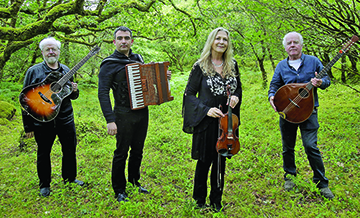
Music Magic: Irish concerts are one of the charms during St. Patrick’s Day weekend. With more than a million records sold, Irish folk band Altan entertains at the Lakewood Center March 11.
Luck, charms, shamrocks, and shenanigans, Dublin days in Denver begins March 9 at 3 p.m. (weather permitting) when the city paints a green strip down Blake Street. From that day and after, St. Paddy’s Day events begin with just a “wee bit” O’ Blarney. The green stripe signifies the parade route and is followed by the Changin’ of Blake’s Street sign to Tooley Street, honoring 1970s Irish former District Attorney Dale Tooley.
All the days thereafter, according to Irish folklore, will be filled with fond memories, happiness, and laughter throughout St. Patrick’s Day on March 17.
Get ready for one of the nation’s biggest St. Patrick’s Day Parades on March 11, followed by days of revelry from shamrock-covered bars serving classic pub grub with music, drinking, and a whole lot of green. Embrace the luck and prepare for revelry and merrymaking with the Chronicle’s yearly guide to partying in green garb:
Concerts
Luck of the Irish, March 4-5: The Aurora Singers entertain with haunting ballads, lullabies, and songs to stir your Irish soul at South Middle School, Sat. 7 p.m., Sun. 2 p.m. Information: 303-343-3377.
Gobs O’ Phun, March 5 & 17: Brothers-in-law duo-duet Denis Sullivan and Martin Lambuth accompany themselves with guitar, bodhran, and harmonica at Swallow Hill’s Quinian Café, 7 p.m., and on St. Paddy’s Day, 8 p.m. Information: 303-777-1003.
Young Dubliners, March 10: Irish-American rock band and lead singer-rhythm guitarist Keith Roberts perform at the Soiled Dove Underground in the Lowry Town Center, 8 p.m. Information: 303-830-9214.
Celtic Awakening, March 10-12: The Denver Brass Celtic show with the Colorado Pipes & Drums, Wick School of Irish Dance, the Rocky Mountain Highland Dancers, and Irish tenor Todd Teske bring Irish magic to the Newman Center, 7:30 p.m. Information: 303-871-7720.
Altan, March 11: The 1987 Irish folk band formed by lead vocalist Mairead Ni Mhaonaigh and her husband Frankie Kennedy and sold over a million records is at the Lakewood C

Popular Procession: Denver’s Irish parade is accompanied by Celtic Music Groups, Acoustic Bands, plus Irish Music Bands. Hip hounds march along with horses in the annual parade.
enter, 7:30 p.m. Information: 303-987-7845.
Parade & Princess
Set to step off March 11 at 9:30 a.m., Denver’s St. Paddy’s Day parade is one of the largest in the country with nearly half a million people expected. Featuring Irish step dancers, marching bands, elaborate floats, and bagpipers, the Mile High version is legendary.

St. Paddy’s Swarm: Nearly a half million people are expected downtown for the St. Patrick’s Day Parade March 11. Irish marching bands, floats, and bagpipers annually draw state’s single largest gathering in one place.
Many claim it annually draws Colorado’s single largest gathering in one place.
If you’re attending, you’ll want to get a spot early since some people arrive by 6 a.m. to find a prime place for spectating. The parade launches from Wynkoop at 19th, turns down 17th in front of Union Station, and then turns NE down Blake St. proceeding all the way to 27th. Information: 720-577-6884.
Competition to be Denver’s next Irish queen — known as Queen Colleen — was set from Feb. 11, after the deadline for the Chronicle’s March issue. Currently Miss Colorado All American Girl, Molly Casey served as Queen Colleen for 2022. Born and raised here, she is 100% Irish and still visits her family’s homestead in Cork, Ireland.
Pub Grub
The Abbey Tavern: A bright, relaxing eatery on E. Colfax serving American breakfasts and brunch, patrons can also choose from an Irish Breakfast, a Corned Beef Hash Skillet, Irish Eggs Benedict, plus Shepherd’s Pie. Irish Bread Pudding is available for dessert. Information: 303-321-5151.
Casey’s Bistro & Pub: Located in the Lowry Town Center, this lively restaurant-bar’s menu includes Irish Nachos, Bangers & Mash, Shepherd’s Pie, plus Irish Whiskey Chicken. Information: 720-974-7350.
The Irish Rover: This friendly Baker neighborhood pub on South Broadway is celebrating St. Paddy’s Day March 12-17. With a fireplace and huge rooftop patio, diverse food choices are always available. Irish selections include a Corned Beef Reuben, Shepherd’s Pie, and an Irish

Corned Beef Custom: Corned Beef & Cabbage has become a yearly St. Paddy’s Day Special at the Monaco Inn Restaurant. The hoped-for coming year fortune dish is being served for lunch and dinner March 17.
Breakfast. Information: 303-282-4643.
Monaco Inn Restaurant: When Irish eateries began to shutter a dozen years ago, this South Monaco Parkway restaurant started offering Corned Beef & Cabbage as a St. Patrick’s Day Special. The dish quickly became a draw, and will again be the March 17th Special for lunch and dinner. Information: 303-320-1104.
Scruffy Murphy’s Irish Pub: An authentic slice of the Emerald Isle on Larimer St. near Coors Field, the kitchen serves Shepherd’s Pie, Banger’s ’n Mash, plus Irish Spring Rolls. Information: 303-291-6992.
Pub Places To Play
Clancy’s Irish Pub, March 17-18: State’s oldest and longest running Irish Pub has live music Fri., 8 a.m.-1 a.m;, Sat., 10 a.m.-1 a.m. Among outdoor headlines Fri.-Sat. are Bleed N Green, No B ueno, and The Delta Sonics, plus dozens more entertaining inside. Information: 720-456-7320.
ueno, and The Delta Sonics, plus dozens more entertaining inside. Information: 720-456-7320.
Keggs & Eggs, March 17: Annual St. Paddy’s Day morning concert hosted by rock station KTCL returns to Jackson’s Sports Bar across from Coors Field, 7 a.m. Singer Matt Maeson and bands Holdfast and Ripe entertain. Information: 303-298-7625.
Pig & The Sprout, March 17: Restaurant at 19th & Chestnut Place hosts 5th annual St. Paddy’s Day bar crawl with a $1,000 costume contest, 4 p.m. Information: 720-535-9719.
St. Paddy’s Day Block Party, March 11, 17-18: Live music and parties at the Gin Mill & Larimer Beer Hall noon-4 p.m. Sat.; 3-7 p.m. Fri. 17th & 1-4 p.m. Sat. 18th. Information: 303-295-0706.
Running Luck
Races & Irish Festival, March 12: Family 7K, 2 mile race-walk at Wash Park, 10 a.m. Post-race party with Irish music and dancers, plus Beer Garden. Information: rungreen7K.com.

by Valley Gadfly | Jan 19, 2023 | Main Articles
Property, Violent Crimes Soar Past New York City, Chicago; With 100 Cars Stolen Daily, Auto Theft Is Nation’s Second Highest
by Glen Richardson
 Once amazingly safe, crime in the Mile High City is now worse than New York City or Chicago, and growing increasingly dangerous as the new year begins. Ranked on a scale of 1 (low crime) to 100 (high crime), Denver outranks New York City in violent crimes by 2.5 points. Denver’s property crime has doubled that in New York City. Chicago continues to edge Denver in Violent Crime (19.2 points), but property crimes in Colorado’s capital are 4.5 points greater than in the Windy City.
Once amazingly safe, crime in the Mile High City is now worse than New York City or Chicago, and growing increasingly dangerous as the new year begins. Ranked on a scale of 1 (low crime) to 100 (high crime), Denver outranks New York City in violent crimes by 2.5 points. Denver’s property crime has doubled that in New York City. Chicago continues to edge Denver in Violent Crime (19.2 points), but property crimes in Colorado’s capital are 4.5 points greater than in the Windy City.
Denver’s violent crime rate has been rising over the last 10 years and especially the last two. Furthermore, police don’t believe the pandemic triggered the crime spike. Denver Police Department records show 6,810 aggravated assaults, robberies, and homicides through mid-December, up from just 4,924 in 2019. Property crimes during the same period totaled 42,100, up from 26,133 in 2019. Most come from just a portion of the city’s 78 neighborhoods. The higher-income neighborhoods located east of Broadway and south of Martin Luther King, Jr. Boulevard have lighter violent crime numbers than Denver’s urban core and southwestern neighborhoods.
Auto theft is now an epidemic in Denver and the second highest in the nation. Denver Police Department data as of Dec. 5, 2022, showed auto theft had skyrocketed 71% compared with the city’s three-year average. The car theft rate in Denver is now averaging 19.8 crimes per 1,000 residents. Nearly 100 vehicles are stolen every day in Denver. Furthermore, Colorado now leads the nation in auto theft per capita.
Least Safe City

People wielding guns recorded 6,810 assaults, robberies, and homicides through mid-Dec. 2022.
Denver now also ranks as one of the nation’s least safe cities, according to data
from website WalletHub. The study analyzed 182 U.S. cities for home and community safety, natural disaster risk, and financial safety, then gave each city an overall score and reported the results. Denver is sandwiched in between Little Rock and New Orleans in terms of overall safety.
Colorado’s largest city ranked 166th for home and community safety, in between Baltimore and Fort Lauderdale. Denver’s growing troubles with elevated property and violent crime, low first responder recruitment, high homelessness concentrations, and growing drug overdoses played large roles in the low ranking. While Denver doesn’t have hurricane or earthquake risks, the city ranks extremely high for risks from wildfires, hail, and tornados. The website ranked Denver 139th for natural disaster risk.
On the plus side, the Mile High City’s financial security ranks high. Of 182 cities, Denver ranked 62nd for financial safety. The city’s high concentration of high-income workers and rebounding post-COVID unemployment likely pushed the personal financial measurements higher.
Risky, Safe Spots
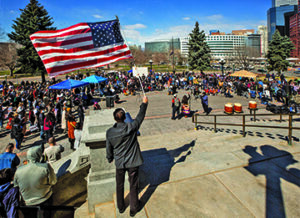
Hate Crime Rally: Colorado had more hate crimes in 2021 than any year since the FBI began tracking them in 1990. Photo is of Denver Asian-Pacific Islander hate crime rally.
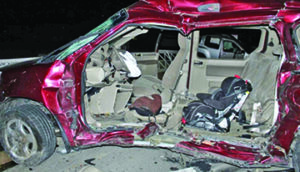
Auto Theft Epidemic: Stolen vehicles are often wrecked and stripped according to local police. Chart, below, shows thefts per 1,000 residents from 2008 to 2021. From six per 1,000 residents in 2008, thefts jumped to 18 in 2021. At end of 2022 it’s at 19.8.
Five Points continues its multi-year streak as Denver’s most violent neighborhood. The Montbello, and Green Valley Ranch neighborhoods that straddle Interstate 70 rank second and third. The city’s urban nightlife center and public transit hub Union Station ranks fourth. Capitol Hill and Central Park (previously Stapleton) are fifth and sixth, trailed by East Colfax in the seventh spot. Most of Denver’s other high-violence neighborhoods are seated in the city’s southwestern edge.
Five neighborhoods have remained steady for violent crime: Washington Park West, Regis, Cory-Merrill, Clayton, and East Colfax.
The biggest news, though, is the drop in violent-crime counts for four of the five areas among the highest in overall offenses: Capitol Hill dropped from 163 in 2021 to 157 in 2022, North Capitol Hill from 104 to 85, and the Central Business District from 185 to 131. Union Station also dropped, albeit a single point, from 167 to 166.
The city’s south-end Wellshire neighborhood — at E. Hampden Ave. between Colorado Blvd. and University Blvd. — is Denver’s safest area. North Park Hill, Wash Park, Country Club, and Hilltop also recorded low violent crime rates compared to the city’s other districts.
Crime Surge Statewide
T
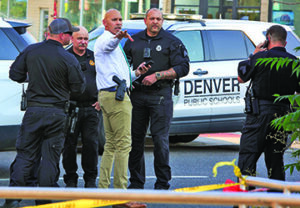
Busy Beat: Calls to potentially deadly crime scenes continue to surge in Denver. Officers are pictured at a September shooting next to the Carla Madison Center where two juveniles were hospitalized. Photo: Jeremy Sparig
he 2022 crime rate statewide was also up — averaging 530 crimes per 100,000 residents — with no relief in sight for the year ahead. While slightly lower than 2021’s peak, crimes in Colorado remained 7.3% higher than in 2019, and 20% higher than in 2008. Incidents of robbery, arson, car theft, vandalism, prostitution, and the purchase of stolen property continued to increase in 2022. Compared to other states, Colorado ranks first in motor vehicle theft and second in property crimes.
Concurrent with Colorado’s rising crime rates, since the start of the pandemic, incarceration in the state’s Department of Corrections facilities have dropped by 15.5%. Moreover, the number of offenders on parole declined by 14.1%, and the number of offenders on probation fell by 14.4%.
For the sake of public safety and justice for victims, law enforcement officials imply that a rise in crime should create a corresponding rise in arrests, convictions, and incarceration.
Hate Crimes Climb
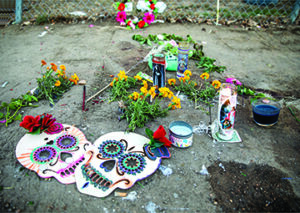
Surge In Violence: Memorial where six people were shot on E. Colfax Ave. on Nov. 2, 2022. Photo by Denverite’s Kevin J. Beaty
Colorado had more hate crimes in 2021 than any year since the FBI began tracking them in 1990. There were 285 reported to the agency, up from 280 in 2020. Data for 2022 isn’t yet available. The state saw a 138% jump in reported hate crimes between 2018 and 2019, and an additional 23% surge in 2020.
In the last five years, three out of every 10 Coloradans experienced a hate crime. More: an October 2022 Hate Free Colorado survey found that most of those crimes go unreported. The survey also indicates that racial and ethnic minorities are 1.5 to 2 times more likely to experience hate crimes than white Coloradans. It also found that only 18% of hate crimes are reported to law enforcement and just 29% are reported to workplace managers or others in authority.
Collected statewide data indicates that 60% of hate crimes in the state are committed based on someone’s race or ethnicity; 20% due to sexual orientation; another 12% because of religion. Additionally, the FBI found the offender’s race was overwhelmingly white.” This is a wake-up call that more must be done at the local, state, and federal level to address the rise in hate,” warns Scott Levin, regional director of the Anti-Defamation League.
Denver Vs. NY & Chicago Charts:
New York, NY Denver, CO United States
Violent Crime 28.2 30.7 22.7
Property Crime 24.9 50.8 35.4
Chicago, IL Denver, CO United States
Violent Crime 49.9 30.7 22.7
Property Crime 46.3 50.8 35.4






































